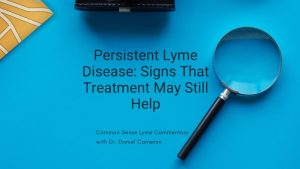
Feng and colleagues from Johns Hopkins University have identified FDA-approved drugs that might work on in vitro B. burgdorferi persisters. [2]
Persistence may be a subset of dormancy. “Evidence suggests dormancy consists of a continuum of interrelated states including viable but nonculturable (VBNC) and persistence states,” according to Mali. “VBNC and persistence contribute to antibiotic tolerance, reemergence from latent infections, and even quorum sensing and biofilm formation.”
Mali’s definition of persister and VBNC cells offers an insight into dormancy:
• “Persister cells have been identified as a “small subpopulation of cells that spontaneously enter a dormant, nondividing state,” a definition based on survival after antibiotic treatment of bacterial cell populations.
• VBNC are “living cells that have lost the ability to grow on routine media.”
 Mali does acknowledge the difficulties differentiating and isolating VBNC and persister cells, pointing out that “both states exhibit enhanced survival under antibiotic treatment.” Persister and VBNC cells may coexist and contribute to reduced metabolic activity, antibiotic tolerance, latent infection, and reemergence of active infections after resolution of stress, he explains.
Mali does acknowledge the difficulties differentiating and isolating VBNC and persister cells, pointing out that “both states exhibit enhanced survival under antibiotic treatment.” Persister and VBNC cells may coexist and contribute to reduced metabolic activity, antibiotic tolerance, latent infection, and reemergence of active infections after resolution of stress, he explains.
The authors point out the difference between persister and VBNC as a starting point for discussion:
• “We propose to describe persister cells as proliferation-competent cells that can spontaneously resuscitate after resolution of stress.”
• “VBNC cells are induced into a non-proliferative state by external stress and will not resuscitate spontaneously until an appropriate external signal is provided.”
The authors’ work could lead to identification of proteins that drive the dormant state.
References:
- Mali S, Mitchell M, Havis S, Bodunrin A, Rangel J, Olson G, Widger WR, Bark SJ. A Proteomic Signature of Dormancy in an Actinobacterium: Micrococcus luteus. J Bacteriol. 2017 May 8. pii: JB.00206-17. doi: 10.1128/JB.00206-17.
- Feng J, Auwaerter PG, Zhang Y. Drug combinations against Borrelia burgdorferi persisters in vitro: eradication achieved by using daptomycin, cefoperazone and doxycycline. PLoS One. 2015;10(3):e0117207.



Obviously.
You don’t reference Kim Lewis’ fantastic work on B. burgdorferi persisters at Northeastern.
I agree. Here is the link to the Northeastern article on persisters.
I’m getting your emails so I must be subscribed already
good